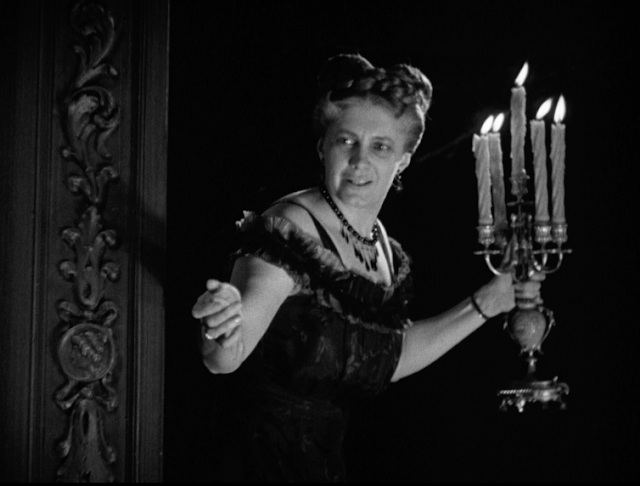1934, 75m 49s (Kino Lorber BD)
Not so much a horror film as a stagebound photo-play with a blood-chilling performance at its fore, this pre-code Paramount thriller is based on a highly successful play by Elizabeth A. McFadden and reunites two members of its original Broadway cast: Anne Revere (who went on to a successful film career) and Mary Morris, who, although she steals this film and single-handedly makes it a must-see, never made another movie. (She lived to the age of 74 in 1970.) Her Broadway performance struck such a popular nerve that she's introduced with perhaps the most prominent (nay, ogreish) screen credit I can recollect of any horror star of the 1930s, bursting through a pair of double doors to the menacing tune of Bach's "Toccata and Fugue in D Minor."
The story takes place inside the New York family mansion of one of the state's richest clans, the Van Bretts, and begins on the occasion of dashing half-brother Rip Van Brett's (Kent Taylor) marriage to the lovely Anne Darrow (Evelyn Venable), an event which Rip's stone-faced, ice-veined older sister Victoria (Morris) does everything she can to spoil. With Anne's encouragement, the two young lovers escape to their honeymoon with spirits intact, but Rip is the product of a lifetime of psychological abuse and diminishment at Victoria's hands. When the couple return to the mansion after their vacation, he gradually slides back into his old spineless ways, which leads to Anne suffering similarly to the point where it becomes a her-or-me situation. When it looks like Rip just might side with his wife, Victoria ramps things up by descending into utter madness, kidnapping Anne - presumed to have simply left Rip - and holding her captive behind the double doors of a secret soundproof, airtight room behind one of the living room walls.
What makes DOUBLE DOOR stand out is not only the blood-and-thunder performance of Morris (whom the Brooklyn DAILY EAGLE likened to "a kind of female Frankenstein") but also its transfiguration of the secret, locked room trope into a Grand Guignol death trap, and also the cinematography of Harry Fischbeck (TERROR ABOARD), which is openly playful with non-realistic lighting effects as Morris' fuming histrionics edge into stark hysteria. It's also a pleasure to see Kent Taylor (so familiar to many of us from his end-of-the-road appearances in Al Adamson films) at his best, and he and Evelyn Venable - who made a number of films together - are so comfortable with one another as to look genuinely in love. Also present in a brief but key role as the family attorney is Halliwell Hobbes, known for his appearances in DRACULA'S DAUGHTER and other Universals.
An early directorial outing for Charles Vidor (best remembered for GILDA, and reputedly a co-director on MGM's 1932 THE MASK OF FU MANCHU), DOUBLE DOOR is to this day an obscure film, which makes its arrival on Blu-ray seem all the more uncanny and miraculous. Following its initial release, it disappeared (possibly due to the Van Bretts bearing too close a similarity to the members and pets of the wealthy and much-publicized Wendel family of that period) and remained in Paramount's vaults until MCA acquired the studio's pre-1948 titles and released it to television circa 1961. A few lucky horror fans of that period remember stumbling across it when it was booked into their favorite spook show, but nothing of any substance was written about it until William K. Everson included it in the "Horror As A Bonus" chapter of his MORE CLASSICS OF THE HORROR FILM, first published in 1986. Everson wrote that DOUBLE DOOR was "one of those films that is recalled with awe, affection, and not a few shivers from those who saw it on its original release." He spoke of Morris' performance in particular as "venomous" and "witchy," and also criticized it for going too far over the edge in the closing reel - but that's exactly what makes the film so scary and so much fun; it's like those precious few moments from SH! THE OCTOPUS rendered as a slow 75m boil. Until the arrival of Kino Lorber's Blu-ray just a couple of months ago, anyone who had seen the picture only knew it from a dark and poorly defined bootleg that was kicking around from an old 16mm source.
Kino Lorber's disc is further enriched in value with two highly informative audio commentaries, one by Tom Weaver (I enjoy his use of voice actors to bring more personality to quoted sources, but I wish he would leave the gratuitous comic sound effects at home), and another by David Del Valle and Stan Shaffer, who engage in a stimulating, sometimes rapid-fire discussion. At one point, David theorizes that Victoria's escalating evil is motivated by her incestuous longing for half-brother Rip, arguing there is "no other" motivation for all she does. I agree she's motivated by sexual resentment, but I prefer another explanation: that she's a deeply frustrated, past-prime spinster, now so undesirable in her character that not even her vast millions can entice any suitors to her door.
Subscribe to Tim Lucas / Video WatchBlog by Email
If you enjoy Video WatchBlog, your kind support will help to ensure its continued frequency and broader reach of coverage.




